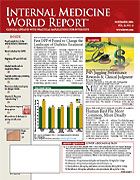Publication
Article
Internal Medicine World Report
Screen All Commercial Drivers for Obstructive Sleep Apnea
Author(s):
Sleep apnea and driving can be a volatile mix. Affected patients are 2 to 7 times more likely to be in an at-fault motor vehicle accident, but despite being more common than diabetes, sleep apnea is often unrecognized by patients and physicians. Although it’s not necessarily your role to keep drivers alert on the road, properly screening all commercial drivers for sleep apnea can prevent many traffic accidents and save life.
Updated screening guidelines for obstructive sleep apnea (OSA) in commercial drivers call for physicians to increase awareness of the prevalence of sleep apnea in the general population as well as among professional drivers.
Current guidelines from the Federal Motor Carrier Safety Administration (FMCSA) were based on a 1991 report, said Natalie P. Hartenbaum, MD, MPH, of the American College of Occupational and Environmental Medicine, which issued the new guidelines in association with the American College of Chest Physicians and the National Sleep Foundation (J Occup Environ Med. 2006; 48[suppl]: S1-S37). “Outdated guidance from the FMCSA has left medical examiners in conflict with current sleep guidelines,” she said.
Dr Hartenbaum added, “With recommendations based on current literature, and accepted by both occupational medicine and sleep medical organizations, a more consistent process for medical certification of these drivers can occur, decreasing the risk of accidents.”
Estimates suggest that as many as 28% of commercial vehicle drivers have some form of sleep apnea (J Occup Environ Med. 2006; 48: 871-872). The generally larger commercial trucks represent more deadly weapons on the highway, and drivers who are paid by the mile may push themselves beyond their limits. This is why commercial drivers are required to undergo medical qualification exams every 2 years.
Physicians who are asked to evaluate a patient’s fitness for operating a commercial vehicle should begin by asking about sleep disorders, pauses in breathing during sleep, daytime sleepiness, and loud snoring. Since a driver seeking certification may be unwilling to admit to any of these, the bed partner might be a more reliable source of information. Patients should also be asked if any healthcare provider has ever said that they have or may have sleep apnea or any other sleep disorder.
If the history suggests sleep apnea, ask the patient about past motor vehicle accidents, and try to determine if any were due to fatigue or inattention, since both are good predictors of future sleep-related accidents.
The diagnosis of OSA is based on history, physical examination findings, and an apnea-hypoxia index ≥5. Patients diagnosed with this condition should be referred for a confirmatory polysomnogram, followed by treatment, typically with continuous positive airway pressure (CPAP).
Those with OSA can still be medically qualified to drive a commercial vehicle if they do not meet the risk criteria for a traffic accident (Table), or if they have documentation of their compliance with CPAP (ie, minimum of 4 hours within a 24-hour period).
Current FMCSA guidelines require drivers to wait at least 1 month after beginning sleep apnea treatment before they resume commercial driving. The new guidelines cut this waiting period to 2 weeks for drivers who are cleared by a sleep specialist, have documented treatment compliance, and have had their blood pressure assessed.





